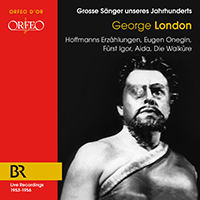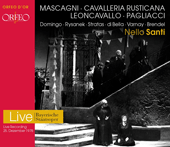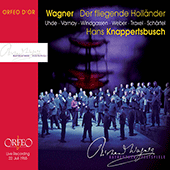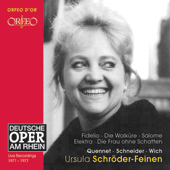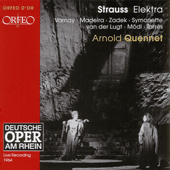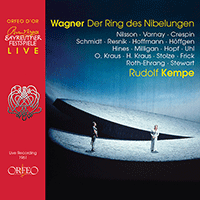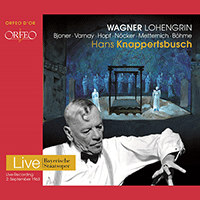Astrid Varnay
Both Varnay’s parents, who were Hungarian, were steeped in the world of opera: her father Alexander Varnay was a tenor and later an opera manager and stage director, while her mother, Maria Yavor Varnay, was a coloratura soprano. At the time Varnay (real name Ibolyka Maria) was born, her parents were running a company called the Opera Comique, established in Oslo and performing in Stockholm in 1918; its members included Kirsten Flagstad.
The family moved to Argentina in 1922 and then on to New York where Varnay’s father worked as a stage director at the Manhattan Opera House before dying unexpectedly in 1924. Two years later her mother remarried, to the tenor Fortunato de Angelis, and they settled in Jersey City. Varnay studied to become a pianist, but at eighteen decided to change to singing, working intensively on vocal technique with her mother. In 1937 (under the pseudonym Ines Melani) she sang Ines / Il trovatore opposite her mother as Leonora at the Brooklyn Academy of Music. Flagstad arranged for her to begin preparing roles with Hermann Weigert, then a staff conductor and coach with the Metropolitan Opera. By 1941, when Varnay auditioned for Edward Johnson, manager of the Met, she could speak five languages (Hungarian, German, English, French and Italian) and had a repertoire of fifteen parts, eleven of which were major Wagnerian roles.
Not surprisingly, Johnson was astounded by her prowess. When in December 1941 he urgently needed a substitute Sieglinde for a broadcast performance of Die Walküre, he turned to Varnay who was happy to oblige, even though she did not have the benefit of a stage rehearsal. The New York Times perceptively wrote of her debut: ‘…the exceedingly comely Swedish-American soprano acted with a skill and grace only possible to those with an inborn talent for the theater.’ Six days later Helen Traubel, scheduled to sing Brünnhilde in the same opera, fell sick and Varnay again substituted with success. She went on to become a mainstay of the Met’s German wing, her roles including Elsa / Lohengrin, Elisabeth / Tannhäuser, Gutrune / Götterdämmerung, Isolde / Tristan und Isolde, Brünnhilde / Siegfried and Eva / Die Meistersinger von Nürnberg, as well as Telea in the world premiere of Menotti’s The Island God (1942). From 1949 and 1950 she began to branch out into the Italian repertory at the Met, singing Amelia / Simon Boccanegra and Santuzza / Cavalleria rusticana, as well as Ortrud / Lohengrin, the title role in Richard Strauss’s Salome and Senta / Der fliegende Holländer.
In 1944 Varnay married Weigert and in the same year made her debut with the Chicago Opera, with whom she sang Sieglinde and Amneris / Aida. She sang with the San Francisco Opera from 1946 onwards, her roles there including the title part in La Gioconda, and in Mexico City in 1948 when she sang the title role in Aida and the Trovatore Leonora. She made her European debut in 1948 at the Royal Opera House, London, performing in short order the Walküre and Siegfried Brünnhildes and Isolde. In 1951 she enjoyed great success at the Florence Maggio Musicale as Lady Macbeth / Macbeth, returned to Covent Garden to sing the Walküre Brünnhilde (alongside Flagstad as Sieglinde), the Trovatore Leonora and the title roles in Aida and Salome; and most particularly made her debut at the newly revived Bayreuth Festival.
Here Varnay was engaged unheard on the recommendation of Flagstad. Her penetrating insight into the psychology of the characters she portrayed and her consequent dramatic realisations appealed strongly to Wieland Wagner, the Festival’s director. She sang continuously at Bayreuth until 1967: as Brünnhilde (1951–1964, 1966–1967), Sieglinde (1954–1955), Gutrune (1954), the Third Norn / Götterdämmerung (1955–1956, 1958, 1967), Kundry / Parsifal (1962, 1965–1966), Isolde (1952–1953, 1963), Senta (1955–1956, 1959) and Ortrud (1953–1954, 1958, 1960, 1962, 1967).
At the end of 1951 Varnay sang her first Götterdämmerung Brünnhilde at the Met under difficult circumstances and once again triumphed. Her first Elektra there came shortly afterwards, followed by a series of major parts: Kundry, the Marschallin / Der Rosenkavalier and Venus / Tannhäuser (as well as Elisabeth), in addition to her established roles. She also created the role of the Old Woman in Banfield’s opera Lord Byron’s Love Letter (New Orleans, 1955). Following the death of Weigert in 1955 Varnay settled in Europe, living in Munich where she was revered, and did not sing at the Met after 1956 until 1974.
Meanwhile, she sang in the major German opera houses and made her debuts at the Paris Opera in 1956 and at La Scala, Milan in 1957 (as Isolde). She returned to London to sing Brünnhilde in the Ring cycles of 1958 (Kempe) and 1959 (Konwitschny) and later, in 1968, made a very powerful impression as the Kostelnička in a revival of Jenůfa under Kubelík. She created the part of Jocasta in the world premiere of Orff’s Oedipus der Tyrann at Stuttgart in 1959 and sang Elektra at the Salzburg Festivals of 1964 and 1965 under Karajan.
As the 1960s progressed Varnay began to refocus her repertoire on mezzo-soprano character roles such as Klytaemnestra / Elektra and Herodias / Salome. She returned to the Met in 1974 to sing the Kostelnička, followed by Klytaemnestra (1975), Herodias (1977) and Begbick / Aufsteig und Fall der Stadt Mahagonny (1979); and also continued to sing with the Bavarian State Opera in numerous roles, such as the Witch / Hänsel und Gretel. Her final stage appearance was in Munich in 1995, as the Nurse / Boris Godunov.
Varnay was able to use her large voice with great artistry in both the German and Italian repertoires. Her intensive preparation enabled her to give performances of such dramatic credibility and power that audiences were frequently left stunned. Her unofficial recorded legacy is large and fully repays investigation.
© Naxos Rights International Ltd. — David Patmore (A–Z of Singers, Naxos 8.558097-100).








